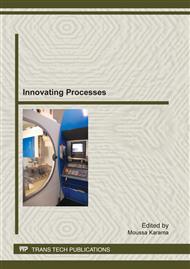[1]
F. Dohmann and C. Hertl: Journal of Materials Processing Technology, Vol. 71 (1997), pp.174-186.
Google Scholar
[2]
Y. Jae-Bong, J. Byung and O. Soo: Journal of Materials Processing Technology, Vol. 111 (2001), pp.175-181.
Google Scholar
[3]
Y.S. Shin, H.Y. Kim, B.H. Jeon B.H., S.I. Oh: J. Mater. Process. Techno. Vol. 130-131 (2002), pp.121-127.
Google Scholar
[4]
R.M. Natal Jorge, Roque A.P., Valente R.A.F., Parente M.P.L. and Fernandes A.A.: J. Mater. Process. Techno. Vol. 184 (2007), pp.363-371.
Google Scholar
[5]
G. Liu, S. Yuan and G. Chu: J. Mater. Process. Techno. Vol. 187-188 (2007), pp.287-291.
Google Scholar
[6]
J.P. Abrantes, A. Szabo-Ponce and G.F. Batalha: J. Mater. Process. Techno. Vol. 164-165 (2005), pp.1140-1147.
Google Scholar
[7]
L. Lang, S. Yuan, X. Wang, Z.R. Wang, Z. Fu, J. Danckert and K.B. Nielsen: J. Mater. Process. Techno. Vol. 146 (2004), pp.377-388.
Google Scholar
[8]
M. Ayadi, A. Cherouat, N. Mezghani and M.A. Rezgui: in 6th International Forum on Advanced Material Science and Technology, Hong Kong June 12-14 (2008).
Google Scholar
[9]
G. Liu, S. Yuan and G. Chu: J. Mater. Process. Techno. Vol. 187-188 (2007), pp.287-291.
Google Scholar
[10]
N. Mezghani, H. Salhi, M. Ayadi and A. Cherouat: International Review of Mechanical Engineering (2009), in press.
Google Scholar
[11]
M. Imaninejad, G. Subhash and A. Loukus: I. J. Mech. Science Vol. 46 (2004), pp.1195-1212.
Google Scholar
[12]
P. Ray and B.J. Mac Donald: Finite element in Analysis and Design, Vol. 41 (2004), pp.173-192.
Google Scholar
[13]
G. Neffussi and A. Combescure: I. J. Mech. Science Vol. 44 (2002), pp.899-914.
Google Scholar
[14]
K.I. Johnson, B.N. Nguyen, R.W. Davies, G.J. Grant and M.A. Khaleel: I. J. Plasticity 20 (2004), pp.1111-1137.
Google Scholar
[15]
S. Yuan, W. Yuan and X. Wang: J. Mater. Process. Techno. Vol. 177 (2006), pp.668-671.
Google Scholar
[16]
M. Koç: J. Mater. Process. Techno. Vol. 133 (2003), pp.276-281.
Google Scholar
[17]
K.J. Fann and P.Y. Hsiao: J. Mater. Process. Techno. Vol. 140 (2003), pp.520-524.
Google Scholar
[18]
K. Manabe, M. Suetake, H. Koyama and M. Yang: I. J. Machine Tools & Manuf. Vol. 46 (2006), pp.1207-1211.
Google Scholar
[19]
T. Hama, T. Ohkubo, K. Kurisu, H. Fujimoto and H. Takuda: J. Mater. Process. Techno. Vol. 177 (2006), pp.676-679.
Google Scholar
[20]
R.M. Natal Jorge, A.P. Roque, R.A.F. Valente, M.P.L. Parente and A.A. Fernandes: J. Mater. Process. Techno. Vol. 184 (2007), pp.363-371.
Google Scholar
[21]
A. Cherouat, K. Saanouni and Y. Hammi: I. J. Mech. Sci. Vol. 44 (2002), pp.2427-2446.
Google Scholar
[22]
M. Imaninejad, G. Subhash and A. Loukus: J. Mater. Process. Techno. Vol. 147 (2004), pp.247-254.
Google Scholar
[23]
P. Bortot, E. Ceretti and C. Giardini: J. Mater. Process. Techno. Vol. 203 (2008), pp.381-388.
Google Scholar
[24]
C. Levaillant and J.L. Chenot: J. Mater. Process. Techno. Vol. 32 (1992), pp.383-397.
Google Scholar
[25]
P. Hora, L. Tong and J.A. Reissner: in Proceedings of Numisheet'96, Wagonner, et al. Eds. (1996), pp.252-256.
Google Scholar
[26]
Liang Xue: Engineering Fracture Mechanics, Vol. 76 (2009), pp.419-438.
Google Scholar
[27]
D. Youn and D. Byeng: Computers and structures, Vol. 82 (2003), pp.241-256.
Google Scholar
[28]
I. Enevoldsen and J.D. Sorensen: Struct. Safety Vol. 15 (1994), p.169–196.
Google Scholar
[29]
Bing, Li, et al.: Journal of Pressure Vessel Technology, Vol. 128 (2006), p.402–407.
Google Scholar
[30]
M. Kleiber et al.: International Journal for Numerical Methods in Engineering, Vol. 60 (2004), pp.51-67.
Google Scholar
[31]
L. Bing et al.: Journal of Pressure Vessel Technology, Vol. 129 (2007), pp.242-247.
Google Scholar
[32]
M. Koç et al.: International Journal of Machine Tools and Manufacture, Vol. 42 (2002), pp.123-138.
Google Scholar
[33]
W. Donglai et al.: Computational Materials Science, Vol. 42 (2008), pp.228-233.
Google Scholar
[34]
T. Jansson et al.: Journal of Materials Processing Technology, vol. 202 (2007), pp.255-268.
Google Scholar


